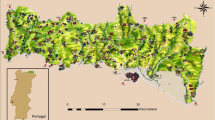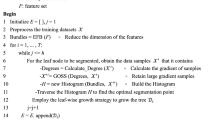Abstract
Aiming at the characteristics of forestry data with high dimensionality and complex samples, this paper explores an ensemble learning method suitable for predicting forest unit volume, which provides a scientific basis for forest resource management and decision-making. According to the real data provided by the National Forestry Science Data Sharing Service Platform, a FL-Stacking model based on hybrid feature selection and ensemble learning is proposed. Firstly, the model extracts features based on Filter-Lasso hybrid method, then constructs the prediction model of forest unit volume based on ensemble learning, and uses eight prediction models such as Linear SVM regression as the fusion basis model in the training set by Stacking scheme. The data are verified by 10 folds cross-validation. Finally, the fusion and optimization of the basic model are carried out. The experimental results show that the optimal accuracy of the single model is 83.81%, the multi-model predicted by FL-Stacking model is 84.55%, and the R2 value is increased by 0.74 percentage points. The comparative analysis results of different models on real data sets show that the FL-Stacking integrated prediction model proposed in this paper has a high accuracy in estimating forest unit volume, and has a great practical research value.








Similar content being viewed by others
References
State Forestry Administration (2014) Results of the eighth national forest resources inventory. For Res Manage (1):1–2
Robert N, John E, Gary M (2009) Handbook of statistical analysis and data mining applications. Elsevier, USA
Vapnik V, Levin E, Le CY (1994) Measuring the VC dimension of a learning machine. Neural Comput 6:851–876
Cover TM, Hart PE (1953) Nearest neighbor pattern classification. IEEE Trans Inf Theory 13:21–27
Breiman L (2001) Random forests. Mach Learn 45(1):5–32
Grossmann E (2004) Ada tree: boosting a weak classifier into a decision tree. In: Proceedings of the 2004 conference on computer vision and pattern recognition workshop. p 105
Breiman L (1996) Bagging predictors. Mach Learn 24:123–140
Zhang C-X, Zhang L-S (2011) A review of selective integrated learning algorithms. Chin J Comput 34(08):1399–1410
Heng W, Kunliang D, Xianglin T, Shuichao S, Jun CS, Pengxiang Z, Tianjian C (2015) Evaluation of site quality of natural secondary forest and artificial forest in Qinling forest region. Sci Sci Technol 51(04):78–88
Pan Y, Raynal DJ (1995) Predicting growth of plantation conifers in the Adirondack Mountains in response to climate change. Can J For Res 25:48–56
Worrell R, Malcolm DC (1990) Productivity of sitka spruce in Northern Britain 1. The effects of elevation and climate. Forestry 63:105–118
Hassall RB, Macmillan DC, Miller HG(1994) Predicting sitka spruce yields in the Buchan area of North-East Scotland. Forestry 67:219–235
Dong W, Zhou G, Xia L et al (1979) Quantitative theory and its application. Jilin People’s Publishing House, Changchun
Ashraf MI, Zhao ZY, Bourque CPA et al (2013) Integrating biophysical controls in forest growth and yield predictions with artificial intelligence technology. Can J For Res 43:1162–1171
Jensen JR, Qiu F, Ji M (1999) Predictive modeling of coniferous forest age using statistical and artificial neural network approaches applied to remote sensor data. Int J Remote Sens 20(14):2805–2822
Guan BT, Gertner G (1991) Using a parallel distributed prcessing system to model individual tree mortality. For Sci 37:871–885
Guan BT, Gertner G (1991) Modeling red pine tree survival with an artificial neural network. For Sci 37:1429–1440
De’Ath G (2007) Boosted trees for ecological modeling and prediction. Ecology 88:243–251
Kuhn M, Johnson K, Lin H (2013) Applied predictive modeling. China Machine Press, Beijing
Yang RM, Zhang GL, Liu F et al (2016) Comparison of boosted regres sion tree and random forest models for mapping topsoil organic carbon concentration in an alpine ecosystem. Ecol Ind 60:870–878
Yin C, Liu M, Sun F-Y et al (2016) Influencing factors of non-point source pollution of watershed based on boosted regression tree algorithm. Chin J Appl Ecol 27(3):911–19
Ou Q-X, Li H-K, Yang Y (2017) Factors affecting the biomass conversion and expansion factor of masson pine in Fujian Province. Acta Ecol Sin 37(17):5756–5764
Ou Q, Li H et al (2018) Comparison of biomass conversion and expansion factor estimation of Pinus massoniana in Fujian based on inventory data—comparison of -3 ensemble learning decision tree models. Chin J Appl Ecol 29(06):2007–2016
Ding L, Luo P (2017) Research on early warning of default risk of P2P online loans based on Staking integration strategy. Invest Res 36(04):41–54
Ye S, Wang X et al (2011) Transient stability assessment of power system based on stacking meta-learning strategy. Power Syst Prot Control 39(06):12–16
Acknowledgements
This work was supported by Social Science Project of Beijing Education Commission (SM201910028017) and Capacity Building for Sci-Tech Innovation - Fundamental Scientific Research Funds of Beijing Education Commission (Grant no.19530050142). Thanks for the China National Forestry Science Data Sharing Service Platform’s Second-Class Survey and Related Data.
Author information
Authors and Affiliations
Corresponding authors
Additional information
Publisher’s Note
Springer Nature remains neutral with regard to jurisdictional claims in published maps and institutional affiliations.
Rights and permissions
About this article
Cite this article
Wang, J., Xu, J., Peng, Y. et al. Prediction of forest unit volume based on hybrid feature selection and ensemble learning. Evol. Intel. 13, 21–32 (2020). https://doi.org/10.1007/s12065-019-00219-4
Received:
Revised:
Accepted:
Published:
Issue Date:
DOI: https://doi.org/10.1007/s12065-019-00219-4




